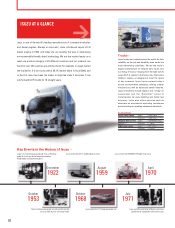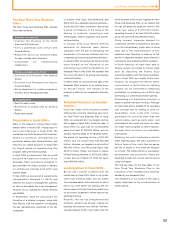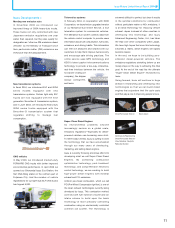Isuzu 2004 Annual Report Download - page 11
Download and view the complete annual report
Please find page 11 of the 2004 Isuzu annual report below. You can navigate through the pages in the report by either clicking on the pages listed below, or by using the keyword search tool below to find specific information within the annual report.
11
Isuzu Motors Limited Annual Report 2004
Isuzu Developments
>>
Meeting new emission rules
In November 2003 we introduced our
improved lineup of GIGA heavy-duty trucks.
These trucks not only conformed with new
Japanese emission regulations one year
earlier than required, but they also qualify for
designation as “ultra-low-PM-emissions diesel
vehicles” by the Ministry of Transport since
their particulate matter (PM) emissions are
75% lower than the allowable limit.
New transmission systems
In fiscal 2004, we introduced ELF and GIGA
series models equipped with new
transmission systems. Certain light-duty ELF
trucks are now equipped with the next
generation Smoother-E transmission system,
and in June 2003, we introduced heavy-duty
GIGA series trucks equipped with the
Smoother-G transmission system that
regulates shifting to manage fuel
consumption.
CNG vehicles
In May 2003, we introduced medium-duty
FORWARD CNG trucks with further improved
environmental performance. In April 2003 we
opened our Shonandai Isuzu Eco-Station, the
first CNG filling station in the northern part of
Fujisawa City. And the number of vehicle
registrations for our light-duty ELF CNG trucks
has topped 5,000.
Telemetrics systems
In February 2004, in cooperation with KDDI
Corporation, we launched an upgraded version
of our Mimamori-kun Online Service, a true
telematics system for commercial vehicles.
The Mimamori-kun system collects data from
the vehicle control computer to provide users
information about fuel consumption, fuel costs,
emissions, and driving habits. This information
can then be analyzed and shared with our
customers to help them improve fuel economy
and encourage safe driving practices. The
online service uses GPS technology and
KDDI’s latest packet telecommunications
technology to provide a two-way, interactive,
real-time interface between the vehicle, the
forwarder (transport
company), the shipper
(cargo consignee),
and Isuzu.
Super-Clean Diesel Engines
As environmental problems become
increasingly serious on a global scale,
emissions regulations—especially for diesel-
powered vehicles—are becoming more strict.
To meet today's needs, Isuzu is putting to work
the technology that we have accumulated
through our many years of developing,
marketing, and selling diesel engines.
Isuzu is currently throwing enormous effort into
developing what we call Super-Clean Diesel
Engines. By combining combustion
optimization technology, post-treatment
technology, and comprehensive electronic
control technology, we are working to build
high-power diesel engines with minimal
exhaust and CO2emissions.
Uniform pre-mixed combustion, which we call
PCI (Pre-Mixed Compression Ignition), is one of
the clean exhaust technologies currently being
developed by Isuzu. This combustion method
controls both fuel injection volume and air
intake volume to build upon the basic
technology of more precisely controlling
combustion using an electronically controlled
common rail system. The technology is
extremely difficult to perfect, but since it results
in the optimal conditions for combustion
without particulate matter or NOx emissions, it
is an ideal technology for reducing vehicle
exhaust. Japan is ahead of other countries in
developing this technology, and Isuzu
Advanced Engineering Center, Ltd., has taken
the lead over other companies within Japan.
We have high hopes that once this technology
becomes a reality, diesel engines will rapidly
become cleaner.
In the end, we hope to be building zero-
emission diesel-powered vehicles. The
emissions regulations stretching before us are
merely steps on the way to achieving this final
goal. At the end of the road lies the ultimate
"Super-Clean Diesel Engine" envisioned by
Isuzu.
Going forward, Isuzu will continue to forge
ahead in researching and developing new
technologies so that we can build diesel
engines that outperform their life cycle costs
and that play a role in improving people's lives.
Diesel Particulate Defuser
Continuously Regenerating
Diesel Particulate Defuser+
Urea-Selective Catalystic
Reduction System
Nox Catalyst
























